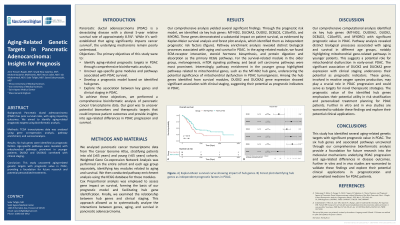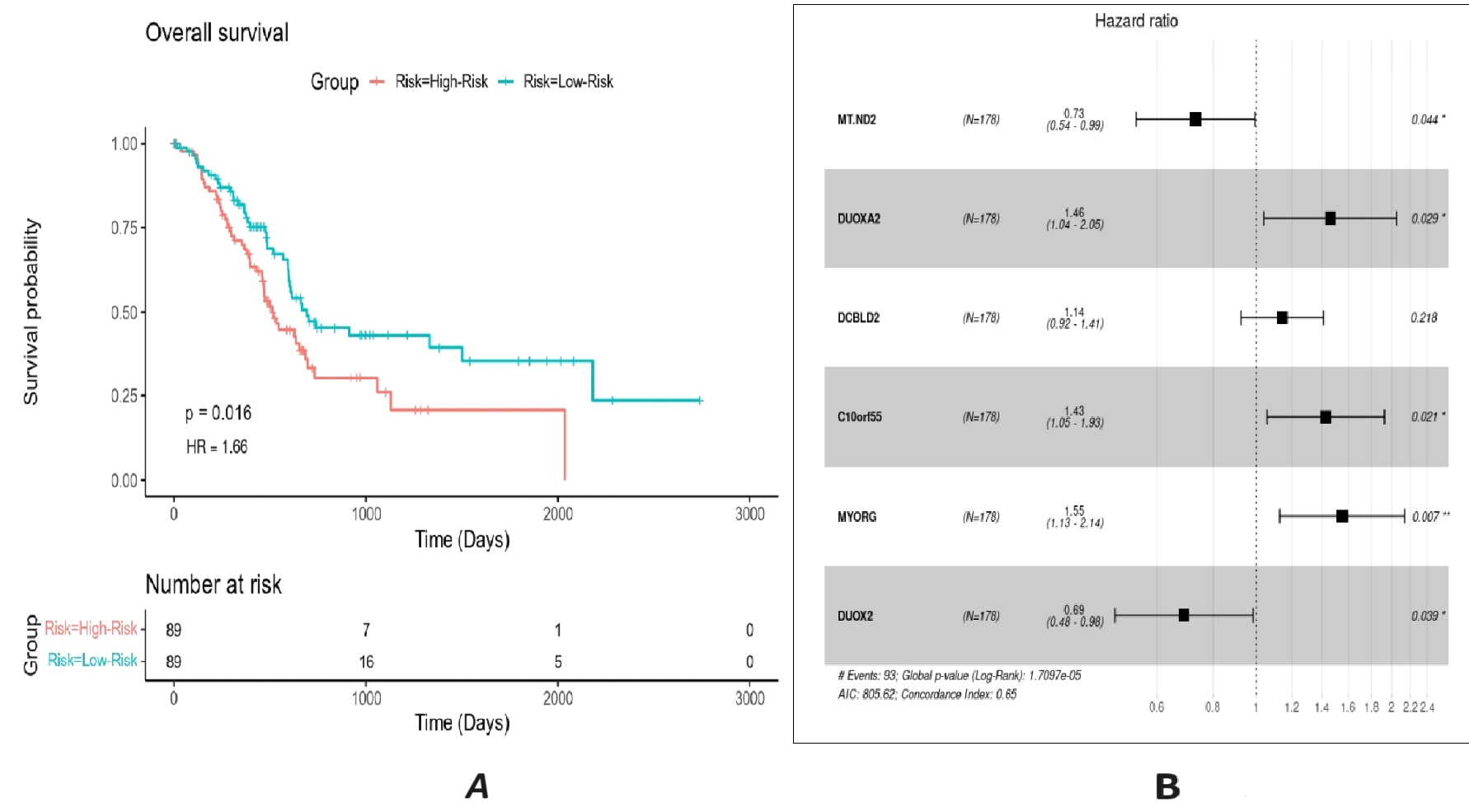Monday Poster Session
Category: Biliary/Pancreas
P1775 - Aging-Related Genetic Targets in Pancreatic Adenocarcinoma: Insights for Prognosis
Monday, October 28, 2024
10:30 AM - 4:00 PM ET
Location: Exhibit Hall E

Has Audio
- ST
Salar Tofighi, MD
Saint Agnes Medical Center
Fresno, CA
Presenting Author(s)
Amir Hossein Rajabi, MS1, Seyed Reza Salarikia, MS1, Mohammadamin Malekraeisi, MS2, Narcis Jafari, MS1, Ida Mohammadi, MS1, Salar Tofighi, MD3, Saeed Soleymanjahi, MD4
1Shiraz University of Medical Sciences, Shiraz, Fars, Iran; 2Iran University of Medical Sciences, Tehran, Tehran, Iran; 3Saint Agnes Medical Center, Fresno, CA; 4Yale New Haven Health, New Haven, CT
Introduction: Pancreatic adenocarcinoma (PAAD) has a 5-year relative survival rate of approximately 8.5%. While the impact of aging on cancer survival is recognized, the underlying mechanisms remain unclear. We performed a comprehensive bioinformatic analysis to identify aging-related prognostic targets.
Methods: We used pancreatic cancer transcriptome data from the Cancer Genome Atlas (TCGA) and categorized the samples into two cohorts based on the age of patients: old (≥65 years) and young (< 65 years). Next, we performed Weighted Gene Co-expression Network Analysis (WGCNA) on all patients together and for the two age groups, separately. We identified three modules: one module with the highest correlation with age-related genes among all patients; and two modules with the highest correlation with overall survival in each age subgroup. Pathway enrichment analysis was conducted using the Kyoto Encyclopedia of Genes and Genomes (KEGG) database in each module. In addition, we used Cox Proportional analysis was conducted to explore genes with the highest survival impact, forming the basis for our multivariable prognostic model and identify the hub genes. Finally, we examined the association of hub genes with clinical staging was examined using the TCGA database.
Results: Using the prognostic risk model, we identified MT-ND2, DUOXA2, DUOX2, DCBLD2, C10orf55, and MYORG as the key hub genes (Figure). In the aging-related module, we found ECM-receptor interaction, steroid hormone biosynthesis, and protein digestion and absorption pathways as the main KEGG pathways. For the survival-related module in the older group, melanogenesis, mTOR signaling pathway, and basal cell carcinoma pathways were the most dominant ones. In contrast, pathway enrichment in the younger group revealed pathways related to mitochondrial genes, such as the MT-ND2 hub gene, highlighting the significance of mitochondrial genes in tumorigenesis. Among hub genes from survival modules, DUOX2 and DUOXA2 gene expression were significantly associated with clinical staging.
Discussion: Utilizing a comprehensive computational biology approach, we analyzed existing databases to identify key aging-related genes with significant survival impacts on PAAC. Future in-vitro and in-vivo studies can further explore the relevance of these genes with prognosis and personalized medicine in PAAC.

Disclosures:
Amir Hossein Rajabi, MS1, Seyed Reza Salarikia, MS1, Mohammadamin Malekraeisi, MS2, Narcis Jafari, MS1, Ida Mohammadi, MS1, Salar Tofighi, MD3, Saeed Soleymanjahi, MD4. P1775 - Aging-Related Genetic Targets in Pancreatic Adenocarcinoma: Insights for Prognosis, ACG 2024 Annual Scientific Meeting Abstracts. Philadelphia, PA: American College of Gastroenterology.
1Shiraz University of Medical Sciences, Shiraz, Fars, Iran; 2Iran University of Medical Sciences, Tehran, Tehran, Iran; 3Saint Agnes Medical Center, Fresno, CA; 4Yale New Haven Health, New Haven, CT
Introduction: Pancreatic adenocarcinoma (PAAD) has a 5-year relative survival rate of approximately 8.5%. While the impact of aging on cancer survival is recognized, the underlying mechanisms remain unclear. We performed a comprehensive bioinformatic analysis to identify aging-related prognostic targets.
Methods: We used pancreatic cancer transcriptome data from the Cancer Genome Atlas (TCGA) and categorized the samples into two cohorts based on the age of patients: old (≥65 years) and young (< 65 years). Next, we performed Weighted Gene Co-expression Network Analysis (WGCNA) on all patients together and for the two age groups, separately. We identified three modules: one module with the highest correlation with age-related genes among all patients; and two modules with the highest correlation with overall survival in each age subgroup. Pathway enrichment analysis was conducted using the Kyoto Encyclopedia of Genes and Genomes (KEGG) database in each module. In addition, we used Cox Proportional analysis was conducted to explore genes with the highest survival impact, forming the basis for our multivariable prognostic model and identify the hub genes. Finally, we examined the association of hub genes with clinical staging was examined using the TCGA database.
Results: Using the prognostic risk model, we identified MT-ND2, DUOXA2, DUOX2, DCBLD2, C10orf55, and MYORG as the key hub genes (Figure). In the aging-related module, we found ECM-receptor interaction, steroid hormone biosynthesis, and protein digestion and absorption pathways as the main KEGG pathways. For the survival-related module in the older group, melanogenesis, mTOR signaling pathway, and basal cell carcinoma pathways were the most dominant ones. In contrast, pathway enrichment in the younger group revealed pathways related to mitochondrial genes, such as the MT-ND2 hub gene, highlighting the significance of mitochondrial genes in tumorigenesis. Among hub genes from survival modules, DUOX2 and DUOXA2 gene expression were significantly associated with clinical staging.
Discussion: Utilizing a comprehensive computational biology approach, we analyzed existing databases to identify key aging-related genes with significant survival impacts on PAAC. Future in-vitro and in-vivo studies can further explore the relevance of these genes with prognosis and personalized medicine in PAAC.

Figure: A) The Kaplan-Meier survival curve for PAAD patients demonstrates that validated hub genes significantly impact the survival rate. B) The forest plot of validated hub genes identifies them as independent prognostic risk factors.
Disclosures:
Amir Hossein Rajabi indicated no relevant financial relationships.
Seyed Reza Salarikia indicated no relevant financial relationships.
Mohammadamin Malekraeisi indicated no relevant financial relationships.
Narcis Jafari indicated no relevant financial relationships.
Ida Mohammadi indicated no relevant financial relationships.
Salar Tofighi indicated no relevant financial relationships.
Saeed Soleymanjahi indicated no relevant financial relationships.
Amir Hossein Rajabi, MS1, Seyed Reza Salarikia, MS1, Mohammadamin Malekraeisi, MS2, Narcis Jafari, MS1, Ida Mohammadi, MS1, Salar Tofighi, MD3, Saeed Soleymanjahi, MD4. P1775 - Aging-Related Genetic Targets in Pancreatic Adenocarcinoma: Insights for Prognosis, ACG 2024 Annual Scientific Meeting Abstracts. Philadelphia, PA: American College of Gastroenterology.
